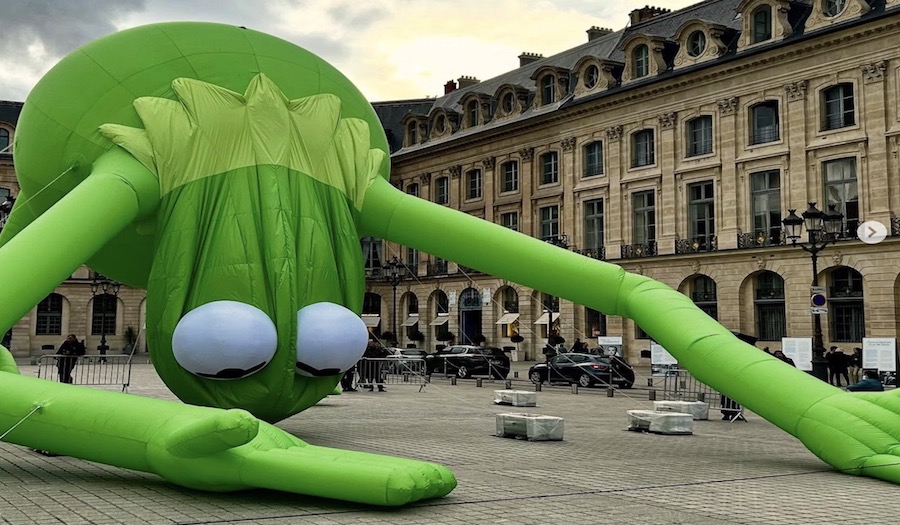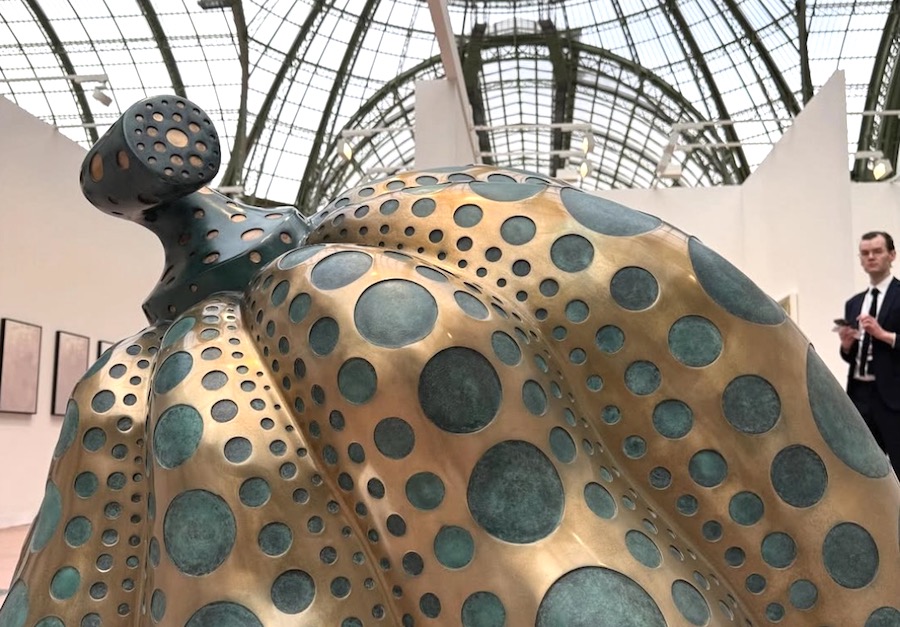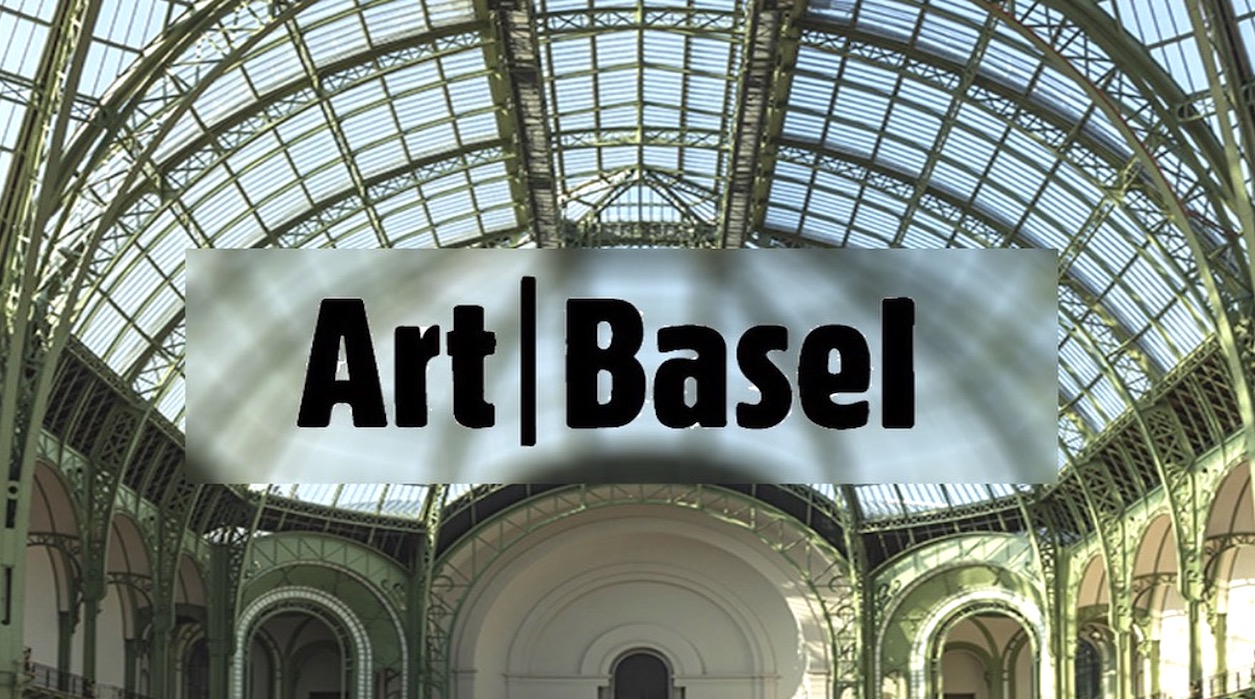Art Basel Paris 2025 has settled into itself. Now in its fourth edition, the fair feels less like an ambitious transplant and more like a native force. Two hundred and six galleries from forty-two countries occupy the newly restored Grand Palais — a temple of glass and iron that now gleams like a symbol of Paris’s revived cultural confidence. Sixty-five of those galleries are homegrown, proof that France’s own scene no longer sits in the shadow of Basel, London, or New York.
The structure remains familiar: the Galeries sector anchors the fair, with its blue-chip dominance and museum-ready canvases; Emergence brings younger voices to the surface; Premise offers curatorial risk; and Magazines provides breathing space in the form of art-world reading material. But this year’s edition has sharpened its edges. “Oh La La!”, the playful special project directed by fashion journalist Loïc Prigent, riffed on the theme “À la mode,” blurring the boundary between the catwalk and the fair stand. The mood — even before the first champagne cork popped — was positive.

The fair’s new Avant Première preview on Tuesday (yesterday), an invite-only prelude to the usual VIP day, could have gone either way. Instead, it became the event of the week. From 3 pm to 7 pm, the Grand Palais turned into an elegant scrum of collectors, curators, and celebrities. “Everybody is here,” said Thaddaeus Ropac. “It’s not so much an avant — it is the premiere.”
Ropac’s confidence was justified. His gallery sold Alberto Burri’s 1953 work for €4.2 million, alongside two Baselitz paintings and an Antony Gormley sculpture. The mood, he noted, was distinctly different from Basel’s flagship fair: “In Paris, people decide faster. They come ready to act.” That urgency seems to define the fair’s new rhythm — leaner, more selective, yet pulsing with intent.
Hauser & Wirth, accustomed to the grand stage, adapted to a more intimate scale. “Last year we couldn’t catch a breath,” said President Marc Payot. “This year, it’s civilised.” Civilised, perhaps, but also lucrative: by the end of the first day, the gallery had placed Gerhard Richter’s Abstraktes Bild (1987) for $23 million, the highest reported sale of the fair. Fontana, Condo, Richter, Mitchell — all found buyers. By contrast, some smaller booths upstairs in Emergence traded on curiosity rather than spectacle.
Numbers tell their own story: about three thousand invitations were issued for Avant Première, half the number expected at the regular VIP preview. The strategy worked. The aisles remained walkable, the conversations audible, and the art visible — rare luxuries at a major fair. Yet outside, the queue stretched from the Grand Palais doors to the edge of the Champs-Élysées, proving that exclusivity has its own gravitational pull.

Paris, as ever, provides the mise-en-scène. Post-Brexit, post-Covid, and with Frieze London showing signs of fatigue, the French capital has reclaimed the crown of cultural glamour. The Grand Palais restoration has coincided with a wave of new openings: Jean Nouvel’s redesigned Fondation Cartier across from the Louvre, the Musée d’Orsay’s radiant Bridget Riley retrospective tracing her dialogue with Seurat, and a cerebral group show at the Centre Pompidou exploring how Foucault, Beauvoir and Fanon continue to shape artistic discourse. The city feels like a place where art breathes rather than merely trades again.
Still, trade remains the oxygen. Pace sold its Modigliani for just under $10 million; Zwirner shifted a Ruth Asawa sculpture for $7.5 million and a Martin Kippenberger for $5 million. Perrotin found buyers for Maurizio Cattelan’s mechanical drummer boy (around €180,000) and a Takashi Murakami canvas for $550,000. Nahmad Contemporary, meanwhile, opted for theatre over transparency: its booth was a sealed shrine to Picasso, walls bare save for the artist’s name. Inside, nine paintings spanned the artist’s life, including a 1947 portrait of Françoise Gilot and a wartime Dora Maar. “People come to Paris for Paris,” said Payot wryly — meaning both the art and the performance of it.
Upstairs, away from the noise, the energy was different. Alex Vardaxoglou, showing for the first time, brought what he claimed was the fair’s most significant work — Mascot (2025), a five-metre freestanding sculpture by Tanoa Sasraku, priced at £185,000. “It’s my first Basel and the best start I could imagine,” he said. The work, exploring heritage and identity, has drawn serious institutional interest. Nearby, London’s Nicoletti and Seventeen galleries shared a booth brimming with younger voices: Abbas Zahedi, Josèfa Ntjam, Justin Fitzpatrick — all selling steadily. “The pace feels slower, more thoughtful,” said dealer David Hoyland. “People look, they think, then they buy.”
This shift in tempo echoes a wider recalibration in the market. The speculative fever that inflated prices before 2020 has cooled, leaving space for dialogue — and perhaps for art itself to reassert its value beyond the transactional. As New York advisor Tanja Weingartner put it: “Now’s the time to buy. The gamblers are gone, and you can finally talk about ideas again.”
Beyond the fair, Paris continues to assert its cultural dominance. The Musée de l’Orangerie revisits the pioneering dealer Berthe Weill, who once championed Picasso and Matisse when no one else would. The Fondation Cartier’s inaugural show, Exposition Générale, brings together 600 works by over 100 artists — from Hirst and Barney to Olga de Amaral — in a curatorial statement that feels both retrospective and futuristic.
Even the Seine has joined the act. As the river’s new banks glitter in the autumn light, Bridget Riley’s optical rhythms at the Orsay seem to pulse in sync, a reminder that the city’s beauty and its art have always moved in parallel.
Art Basel Paris 2025 is, ultimately, a story of convergence — of art, money, and myth. The fair has matured fast, finding a balance between commerce and culture that eludes many of its rivals. Yes, it’s about deals: the Richter millions, the Modigliani moment, the Murakami sale. But it’s also about Paris rediscovering its creative swagger. The city that once defined modern art is now redefining the global art fair.
The fair runs from October 24 to 26, with previews on October 22 and 23. VIP days are restricted; the crowd is refined, the champagne is cold. For now, Paris remains the art world’s most seductive theatre — a place where history, ambition, and beauty meet under glass, and where the question is not whether you’ll see great art, but whether you’ll still remember to look past the spectacle.
VIP days (by invitation only)
Wednesday, October 22, 10 am to 8 pm, First Choice VIP
Wednesday, October 22, 4 pm to 8 pm, Preview VIP
Thursday, October 23, 11 am to 2 pm, First Choice, Preview and One-Day VIP
Public days (access with a ticket or invitation)
Friday, October 24, 11 am to 7 pm
Saturday, October 25, 11 am to 7 pm
Sunday, October 26, 11 am to 7 pm
Visit Art Basel Paris
Address
Grand Palais
Avenue Winston Churchill
75008, Paris
Come with public transportation, operated by RATP
Bus stops: Champs-Élysées – Clémenceau (42, 73, 93); Grand Palais (72, 93)
Métro stop: Champs-Élysées – Clémenceau (1, 13)
RER stop: Invalides (C)
View the Grand Palais floorplan and the Art Basel Paris area map
Tickets for Art Basel Paris are exclusively available for purchase in our online ticket shop.

